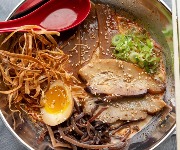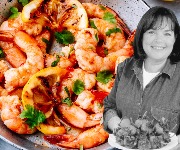This is the month to eat this
This February, we're focusing on rhubarb, which has a special place in the English kitchen. Find out why!
At a time of year when British seasonal ingredients are thin on the ground, rhubarb comes as sweet late winter relief.
Athough classified by botanists as a vegetable, in British cooking, rhubarb has always been treated in a fruit-like fashion. (Incidentally a test case, in New York State in 1947, decided to ignore rhubarb’s essential vegetable qualities and deem it a fruit as it was widely used as such. Disappointingly, the pink rhizome found itself being debated in court not because of any sort of rhubarb-esque existential crisis, the real point being that there was lower taxation on vegetables at the time.)
Rhubarb has a long and ancient history as a tonic, cultivated for its astringent and cathartic properties, the first written reference to it appearing in traditional Chinese medicine as early as 2700 BC and much later in Arabic and European medieval preparations and was a more popular and pricier medicine than opium; prized for treating stomach and liver complaints.
Rhubarb’s widespread use as a food, as opposed to a medicine, came much later and was first recorded in England in the 17th century when sugar became widely available and could be used to sweeten its natural bitterness.
Champagne rhubarb
Although it’s grown around the world – both for food and for producing a rich brown dye which can be made with its roots – rhubarb has a special place in the British – or to be more specific - the English kitchen.
British outdoor-reared rhubarb does not appear until the second half of March and it’s forced rhubarb, so-called because it’s grown in darkened hothouses, that gets us through late winter.
Legend has the ‘forcing’ process accidentally discovered in Chelsea’s Physic Garden in the late 19th century, when some forgotten rhubarb was discovered growing under a plant pot.
Its stems are pale pink, slender and delicate as opposed to the crimson and green, hardy and hefty outdoor-grown variety.
Forced rhubarb, understandably marketed under the much more luxurious-sounding moniker of ‘Champagne rhubarb’, is infinitely less sinewy and much sweeter than conventionally grown rhubarb.
For that reason is championed by chefs over the sort that – if you’re unlucky – you’ll recall from school dinners smothered in lumpy custard.
Although Champagne rhubarb was appropriately first conceived in la-de-da Chelsea, its story is about rich Yorkshire soil and grit.
Champagne rhubarb is grown in hothouses or ‘sheds’ in the so-called ‘Rhubarb Triangle’ that currently consists of twelve growers that force the plant in the traditional method in a triangulation of Yorkshire, between Leeds, Bradford and Wakefield.
Unlikely as it seems, last year it was recognised as a distinctive delicacy by the EU, the 41st British product to be anointed in such a way, awarded a status on a par with Stilton, Parma ham and Champagne itself.
The Rhubarb Triangle
A visit to one of the Rhubarb Triangle’s sheds is a memorable experience, a dark, clammy, otherworldly environment where you could imagine pixies and fairies frolicking amongst the rapidly growing stalks.
Stand there by candlelight in silence for long enough, and you can almost hear squeaking as they force their way through the soil.
At the height of its popularity there were over 200 growers operating in the Triangle, their presence explained by plentiful supplies of fuel and fertilizer for the forcing process.
Until the early 1960s, when rhubarb’s popularity waned, during the forcing seasons a train – dubbed the ‘Rhubarb Express’ ran every night to London loaded with Yorkshire’s finest.
None of which, it must be said, is a load of old rhubarb.
Rhubarb recipes to try at home:
Most Recent
Comments
Be the first to comment
Do you want to comment on this article? You need to be signed in for this feature








